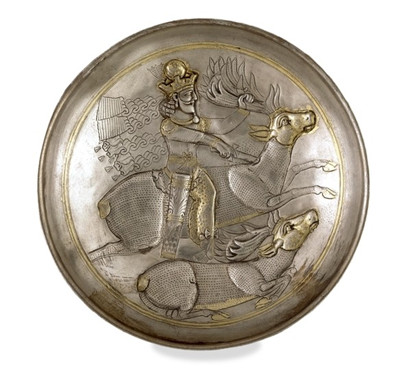(单词翻译:单击)
And all of these notions have of course passed into the Abrahamic mainstream of Judaism, Christianity and Islam.
这些概念都进入了亚伯拉罕诸教—犹太教、基督教与伊斯兰教的教义里。
And it's when you come to the animal that the King is riding on the silver dish that you get a shock, because he's not on a horse but on a fully-antlered stag. He straddles the beast without either stirrups or saddle, gripping it by the antlers with his left hand, while his right hand deftly plunges a sword right into its neck-blood sprays out, and at the bottom of the plate we see the same stag in the throes of death. This whole image is quite clearly a fantasy, from the great crown at the top which would quite clearly have fallen off if you'd been riding, to the idea of killing your own mount in full leap. We're in the realm of symbol.
如果你注意到银盘上国王的坐骑,一定会大吃一惊。他骑的并不是马,而是长着大鹿角的牡鹿。他直接跨坐在没有镫也没有鞍的鹿背上,左手抓着鹿角,右手的匕首灵巧地刺入鹿脖子,鲜血飞溅。银盘的底部还有另一头垂死的牡鹿。整幅图画都有些不真实,比如他头顶的大皇冠,如果真的在骑行,一定早就掉下来了,而刺死正在飞奔的坐骑更是教人不可思议。
What's really going on here? In the Middle East, for centuries, hunting scenes have been a common way of representing royal power. Assyrian kings, well protected in their chariots, are shown bravely killing lions, from a safe distance. But Shapur is doing something else. This is the monarch in single combat with the beast, and he's risking himself not out of pointless bravado, but for the benefit of his subjects. As protective ruler we see him killing certain kinds of animals, the beasts that threatened his subjects: big cats which preyed on cattle and poultry, wild boar and deer which ravaged crops and pastures. So images like this one are visual metaphors for royal power, conceived in Zoroastrian terms.
这到底是怎么回事?千百年来,狩猎场景在中东一向是表现王权的普遍形式。我们曾看到叙利亚国王坐在重重护卫的马车里,在安全距离外英勇地杀死了狮子。沙普尔所做的略有不同。他挺身犯险,与野兽单打独斗,并非盲目逞能,而是在保卫臣民的利益。作为臣民的保护神,我们看到他杀死的都是些危害百姓生活的动物,如猎食家禽家畜的猛兽,破坏庄稼和牧场的野猪与鹿等。这样的图画是琐罗亚斯特教善神的代言人,将战胜一切恶势力,完成身为国王的重大职责。



